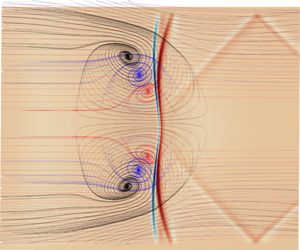Article contents
The effect of flow confinement on laminar shock-wave/boundary-layer interactions
Published online by Cambridge University Press: 11 June 2020
Abstract

Numerical work on shock-wave/boundary-layer interactions (SBLI) to date has largely focused on span-periodic quasi-two-dimensional (quasi-2-D) configurations that neglect the influence lateral confinement has on the core flow. The present study is concerned with the effect of flow confinement on Mach 2 laminar SBLI in rectangular ducts. An oblique shock generated by a  $2^{\circ }$ wedge forms a conical swept SBLI with sidewall boundary layers before reflecting from the bottom wall of the domain. Multiple large regions of flow-reversal are observed on the sidewalls, bottom wall and at the corner intersection. The main interaction is found to be strongly three-dimensional and highly dependent on the geometry of the duct. Comparison to quasi-2-D span-periodic simulations showed sidewalls strengthen the interaction by 31 % for the baseline configuration with an aspect ratio of one. The length of the shock generator and subsequent trailing edge expansion fan position was shown to be a critical parameter in determining the central separation length. By shortening the length of the shock generator, modification of the interaction and suppression of the central interaction is demonstrated. Parametric studies of shock strength and duct aspect ratio were performed to find limiting behaviours. For the largest aspect ratio of four, three-dimensionality was visible across 30 % of the span width away from the wall. The topology of the three-dimensional separation is shown to be similar to ‘owl-like’ separations of the first kind. Reflection of the initial conical swept SBLI is found to be the most significant factor determining the flow structures downstream of the main interaction.
$2^{\circ }$ wedge forms a conical swept SBLI with sidewall boundary layers before reflecting from the bottom wall of the domain. Multiple large regions of flow-reversal are observed on the sidewalls, bottom wall and at the corner intersection. The main interaction is found to be strongly three-dimensional and highly dependent on the geometry of the duct. Comparison to quasi-2-D span-periodic simulations showed sidewalls strengthen the interaction by 31 % for the baseline configuration with an aspect ratio of one. The length of the shock generator and subsequent trailing edge expansion fan position was shown to be a critical parameter in determining the central separation length. By shortening the length of the shock generator, modification of the interaction and suppression of the central interaction is demonstrated. Parametric studies of shock strength and duct aspect ratio were performed to find limiting behaviours. For the largest aspect ratio of four, three-dimensionality was visible across 30 % of the span width away from the wall. The topology of the three-dimensional separation is shown to be similar to ‘owl-like’ separations of the first kind. Reflection of the initial conical swept SBLI is found to be the most significant factor determining the flow structures downstream of the main interaction.
- Type
- JFM Papers
- Information
- Copyright
- © The Author(s), 2020. Published by Cambridge University Press
References
- 16
- Cited by




